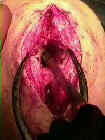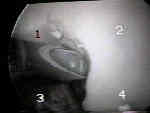- Discussion:
- abnormally narrow intercondylar notches have been shown to correlate directly with an increased incidence of ACL tears;
- w/ excessive internal rotation of the femur, the ACL may be ruptured as it impinges on the edge of the intercondylar notch;
- notchplasty is used to widen the anterior portion and recess of the roof of intercondylar notch;
- close relationship of ACL & roof of intercondylar notch makes rupture of reconstructed ligament possible w/ hyperextension of the knee;
- w/ hyperextension, roof of notch levers on the mid portion of ligament and may cause it to re-rupture;
- Arthroscopic Technique:
- typically a notchplasty involves removal of 3-5 mm of bone from the lateral femoral condyle;
- it is important to widen intercondylar notch by removing anterior inner aspect of the lateral femoral condyle;
- more important than widening the intercondylar notch is deepening anterior roof of the notch to prevent its impinging on ACL when knee
is in full extension;
- anteromedial side of the intercondylar notch is not removed unless osteophytes require removal to the original wall;
- pitfalls: it is important to limit the notchplasty to the anterior portion of the intercondylar notch, and avoid an excess lateral notchplasty
(especially posterolaterally) since this will lateralize the femoral ACL attachment (disrupting the normal knee kinematics);
- resident's ridge:
- ridge of bone on the lateral wall of the notch which can be mistaken for the posterior border of the notch;
- generally this ridge needs to be shaved down so that it is level with the rest of the lateral wall;
- one useful technique is to debride all synovium from the anterolateral aspect of the PCL, which then serves as a landmark;
- the resident's ridge is usually directly lateral to the PCL;
- the motorized burr is then used to shave the ridge, so that it is level with the rest of the notch;
- the true posterior wall of the intercondylar notch should lie approximately 1 cm behind the resident's ridge;
- Assessment of Notchplasty:
- after the tibial tunnel has been drilled, a smooth metal rod (of the same diameter as the drill bit) can be passed thru the tibial tunnel;
- w/ the knee in hyper-extension, the rod should pass easily into the notch;
- if the rod does not pass easily, then there is residual impingement;
- the assessment of the notchplasty should be performed prior to passage of the graft, inorder to prevent abrasion of the graft on the
intercondylar roof
Intercondylar notch measurements with special reference to anterior cruciate ligament surgery.
Topographical anatomy of the intercondylar roof. A pilot study.
- Open Notchplasty: 








